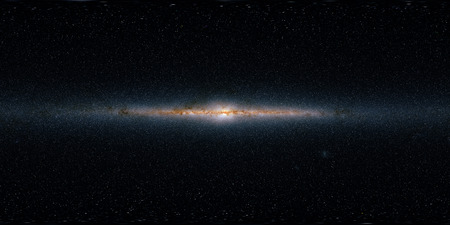The Infrared Milky Way

Image Source: http://www.ipac.caltech.edu/2mass/gallery/showcase/allsky_stars/index.html
This panoramic view encompasses the entire sky as seen by the Two Micron All-Sky Survey (2MASS). The image has been reconstructed from a catalog of measured brightnesses of half a billion stars from the survey.
The 2MASS survey uses near-infrared light at wavelengths longer than that of visible light. At these wavelengths, clouds of dust that obscure our view of more distant stars in our Milky Way galaxy become increasingly transparent. As a result we can see all the way to the very center of the galaxy, showing its overall structure far more clearly than is possible in visible light.
This image is centered on the core of our own Milky Way galaxy, toward the constellation of Sagittarius. The reddish stars seemingly hovering in the middle of the Milky Way's disc -- many of them never observed before. These stars trace the densest dust clouds in our galaxy. The two faint smudges seen in the lower right quadrant are our neighboring galaxies, the Small and Large Magellanic Clouds.
The image is constructed by mapping the three wavelengths of near-infrared light into the three bands of visible light: 1.2 microns to blue, 1.6 microns to green, and 2.2 microns to red.
This equirectangular projection is suitable for mapping onto the surface of a sphere.

